ASUS Mars II GeForce GTX 580 SLI Performance Review
The MARS II is the first dual GeForce GTX 580 card and is part of ASUS ROG brand of premium products targeting the gamer-overclocker market.
By Wong Chung Wee -
A Dual GeForce GTX 580 SLI Monster
In continuity of the Republic of Gamers (ROG) brand, ASUS has unleashed the Mars II, a dual-GPU monster of a card with full knowledge that this brand attracts the most demanding of enthusiasts and gamers. The predecessor of the Mars II is the aptly named Mars. Its build -- two of NVIDIA's GeForce GTX 285 chips packed onto a single graphics card; its raison d'être -- to unleash the NVIDIA GT200 architecture used on those GPUs to its full extent, instead of living with slower clocked GeForce GTX 280-class GPUs on the GTX 295.
Skipping to the present, ASUS has extended the regal lineage of the Mars with the release of Mars II. Its build – two of NIVIDIA’s GeForce GTX 580 GPU running at full speed packed on a card; its reason for existence -- to outperform the current dual-GPU leader, the Radeon HD 6990. In fact, with the ASUS Mars II boasting a GPU/shader clock speed of 782MHz/1564MHz, this surpasses a standard clocked GeForce GTX 580 clocked at 772MHz/1544MHz and definitely a lot speedier than each of the GPUs on the GeForce GTX 590 (clocked at 607MHz/1215MHz). Check this link to see how their specs compare.

The Mars II is an attestation of the engineering strength of ASUS as well as its commitment to the Republic of Gamers (ROG) brand.
Besides being the most powerful card from ASUS now, it is also likely the most expensive card with a SRP of S$2,499. The list of superlatives does not end here. With a limited run of only 999 cards, it is also one of the rarest performance components that money can buy.

The Mars II is a limited edition card and we have in our lab, the 529th card from a limited worldwide run of 999 cards.
The limited edition Mars II has a 21-phase power circuitry which is almost twice as powerful as the 10-phase GPU power supply of the GTX 590. Ensuring stable and timely power to be delivered when required directly to the GPUs is a high capacitance, low ESR and low profile NEC Proadlizer - directly behind each GPU. From our experience with cards featuring this, we've seen better overclocking margins and we believe the Mars II would break new grounds yet again. ASUS has included the GPU Tweak software with a sleek ROG theme GUI for tweaking and maximizing the capabilities of the Mars II.

The NEC/TOKIN Proadlizer appears to be the standard for high-end graphics cards to provide stable power. It is also found on the ASUS Matrix GTX 580 Platinum.
ASUS' GPU Tweak
To complement this impressive hardware package, Asus has included the GPU Tweak software with a sleek ROG theme GUI for tweaking and maximizing the capabilities of the Mars II. The important features of this software are that they allow users to control the voltages, clock speeds and fan speeds easily. It can even lock the clock speeds and voltages such that when the user changes the core clock slider, the core voltage changes correspondingly. This is a nice touch for the less experienced users who may not have any inkling to the appropriate voltages.

A user friendly interface for the enthusiasts to tweak the Mars II.
Manual Override
To provide cooling for the card, a pair of 120-mm fans operates in tandem with eight direct flattened heatpipes (DirectCU design) that contact the GPU directly for quick heat dissipation. There is a dedicated fan switch to crank the fans to their full speeds for maximum cooling.

Pressing the red button will make the fans operate at full speeds, overriding any software settings as well as the auto PWM controlled settings.
Up Close and Personal

The facade of the Mars II with its twin 120mm fans and that massive heatsink, it's claimed to improve operating temperatures by 20% over the standard design.

There are two dual-link DVI (DVI-I) ports, a DisplayPort and an HDMI port. And with its impressive girth, nothing less than three, free expansion slots are required to fit this monster of a card.

There is a SLI connector that allows users who have a pair of Mars II and run Quad-SLI with them; however, with its exorbitant price tag and limited availability, it would be a daunting task!

The name and branding of the Mars II appear the wrong side up from this perspective; this is because it was designed to be easily readable from within a windowed casing as a prized possession. It is a small but thoughtful design gesture.

The three 8-pin power connectors are able to feed more than 500W of power to the Mars II.
After gawking at the impressive external features of the Mars II, we shall proceed to pit this beast of a card against the graphics cards.
Test Setup
As usual, we installed the ASUS Mars II on our test system which has the following specifications:
- Intel Core i7-975 (3.33GHz)
- Gigabyte GA-EX58-UD4P motherboard
- 3 x 1GB DDR3-1333 G.Skill memory in triple channel mode
- Seagate 7200.10 200GB SATA hard drive
- Windows 7 Ultimate 64-bit
We have a fairly new addition to our setup and it is the Dell UltraSharp U3011 30-inch HD monitor. The new display allows us to run some of our benchmark tests at a 2560 x 1600 screen resolution. For the benchmarks run at this resolution (2560 x 1600), we pit the Mars II against two cards and they are the AMD Radeon HD 6970 2-way CrossFireX (Catalyst 11.8) and NVIDIA GeForce GTX 580 1560MB GDDR5 (GeForce 280.26). The graphics driver used for benchmarking of the Mars II was the GeForce 280.26.
At a lower screen resolution of 1920 x 1200, we compared the benchmark scores of the Mars II (GeForce 280.26) with the list mentioned below.
The list of card tested and driver versions used:
- NVIDIA GeForce GTX 590 3GB GDDR5 (ForceWare 267.71)
- NVIDIA GeForce GTX 570 2-way SLI (ForceWare 263.09)
- NVIDIA GeForce GTX 580 1560MB GDDR5 (ForceWare 266.58)
- AMD Radeon HD 6990 4GB GDDR5 (AMD Catalyst 11.4 Preview)
- AMD Radeon HD 6970 2-way CrossFireX (Catalyst 10.11)
The list of benchmarks used:
- Futuremark 3DMark 11
- Futuremark 3DMark Vantage
- Crysis Warhead
- Far Cry 2
- Heaven" from Unigine v2.1
- S.T.A.L.K.E.R.: Call of Pripyat
To kick-start our benchmarking tests, we have the results from Futuremark's 3DMark 11 first. The Mars II blazes away with a score of 10486 points which is more than 19% faster than its worthy competitors. It outscored the NVIDIA GeForce GTX 580 by more than 85%! On the Extreme Preset, the Mars II still came up tops with our AMD 6970 2-way CrossFireX setup nipping at its heels. Still, the Mars II did not disappoint as it pulled away from the pair of AMD GPUs with a 14.5% margin.

On 3DMark Vantage, the Mars II scored consistently higher against the other cards. At the Extreme Preset, it scored slightly over 15% against the pair of Nvidia GeForce GTX 570 (2-way SLI).

Crysis Warhead
For the Crysis Warhead at Enthusiast Settings with no anti-aliasing, the Mars II was edged out by the 2-way CrossFireX setup of the AMD Radeon 6970. At the higher resolution, the Mars II turn tables by about 5.6%. With anti-aliasing turned on, the Mars II performed better on both resolutions, especially with a score that is double that of the AMD CrossFireX setup at the 2560 x 1600 screen resolution.
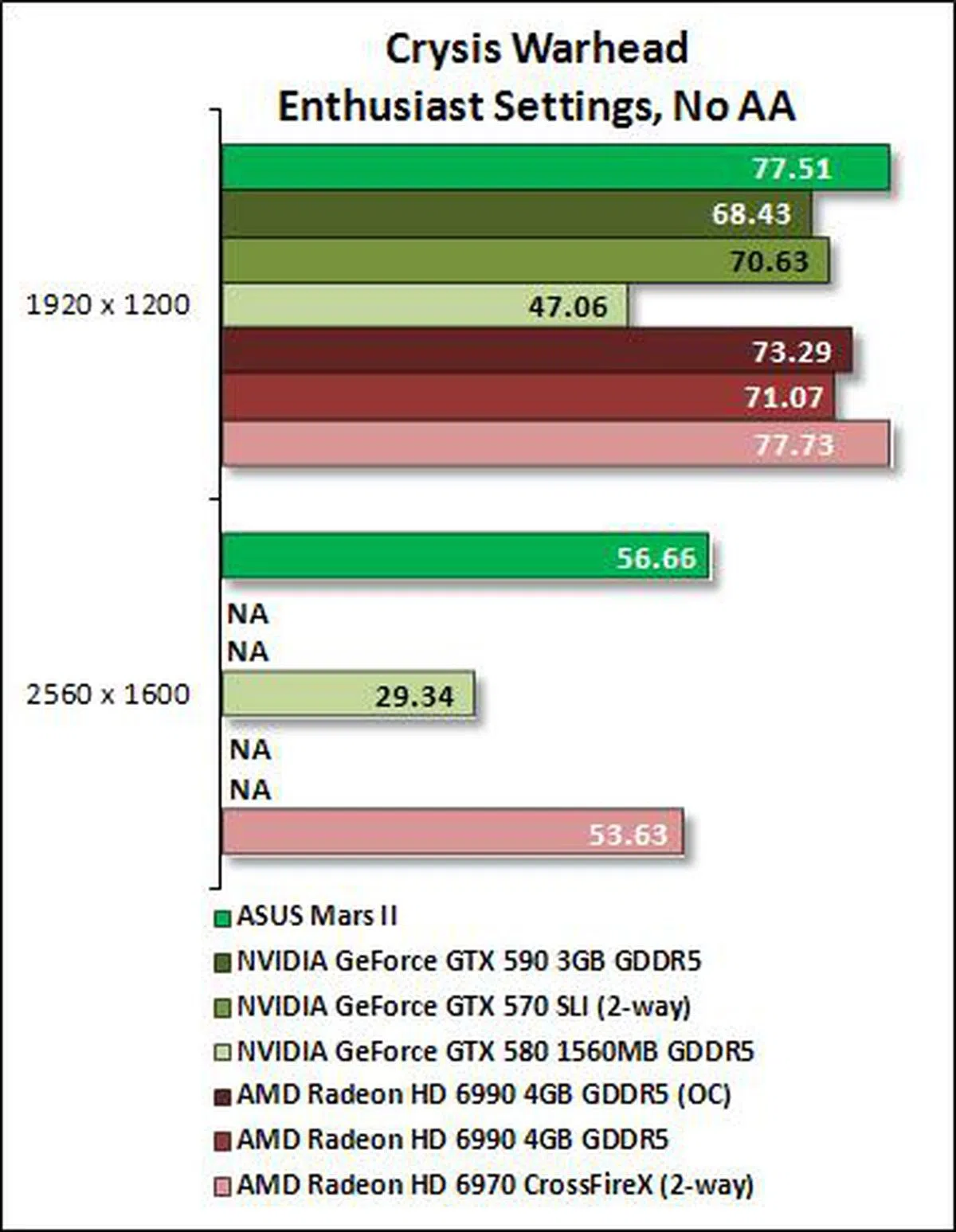 | 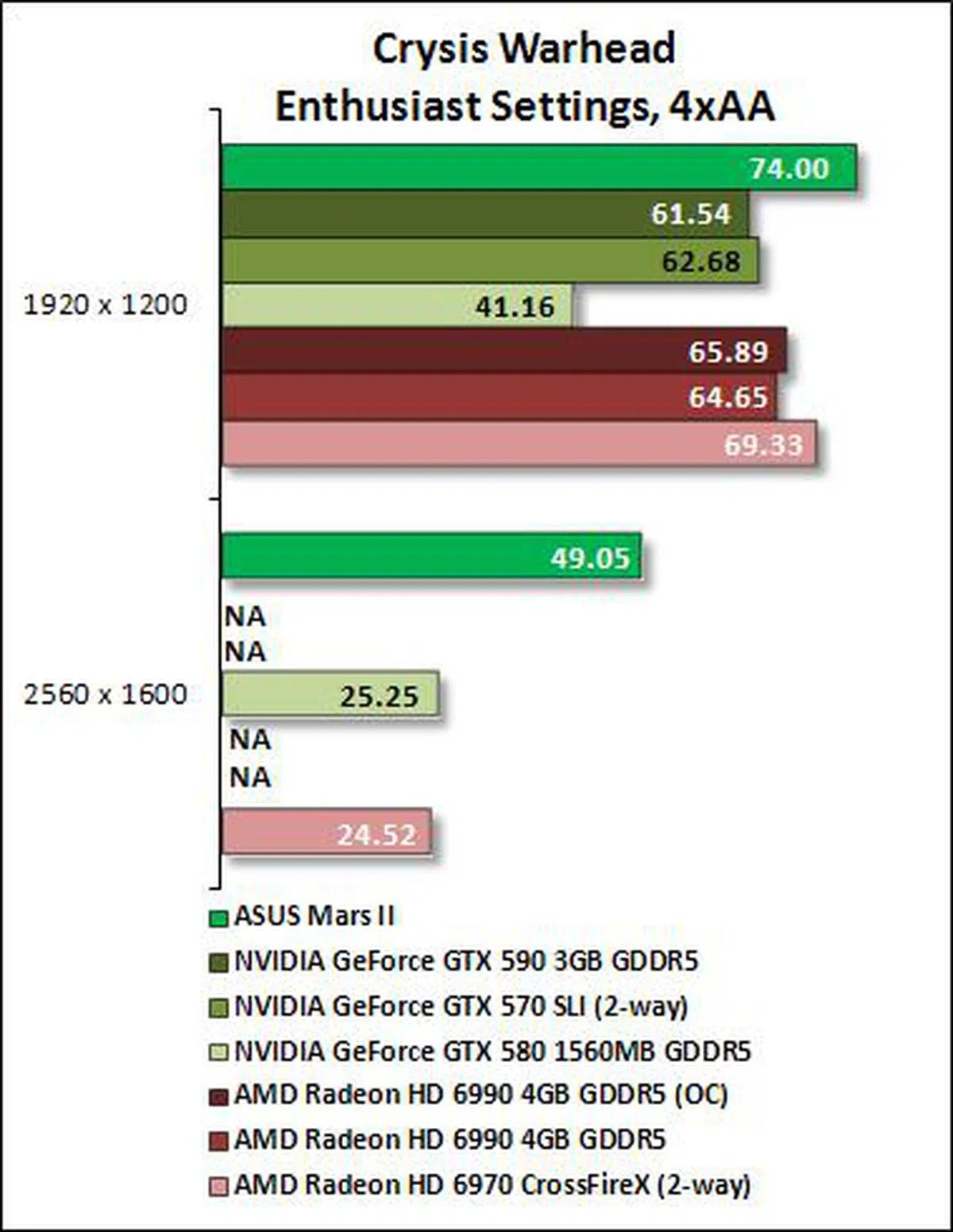 |
Far Cry 2
While Nvidia GeForce cards usually do well on Far Cry 2 and at 1920 x 1200 resolution, the Mars II pulled ahead of the GeForce GTX 570 SLI by nearly 3.8%; however, at the higher resolution, the AMD Radeon 6970 2-way CrossFireX pair topped the Mars II by approximately 1.5% when anti-aliasing was set at 8x. At the lower setting of 4x, it pipped the Mars II by slightly over 4%.
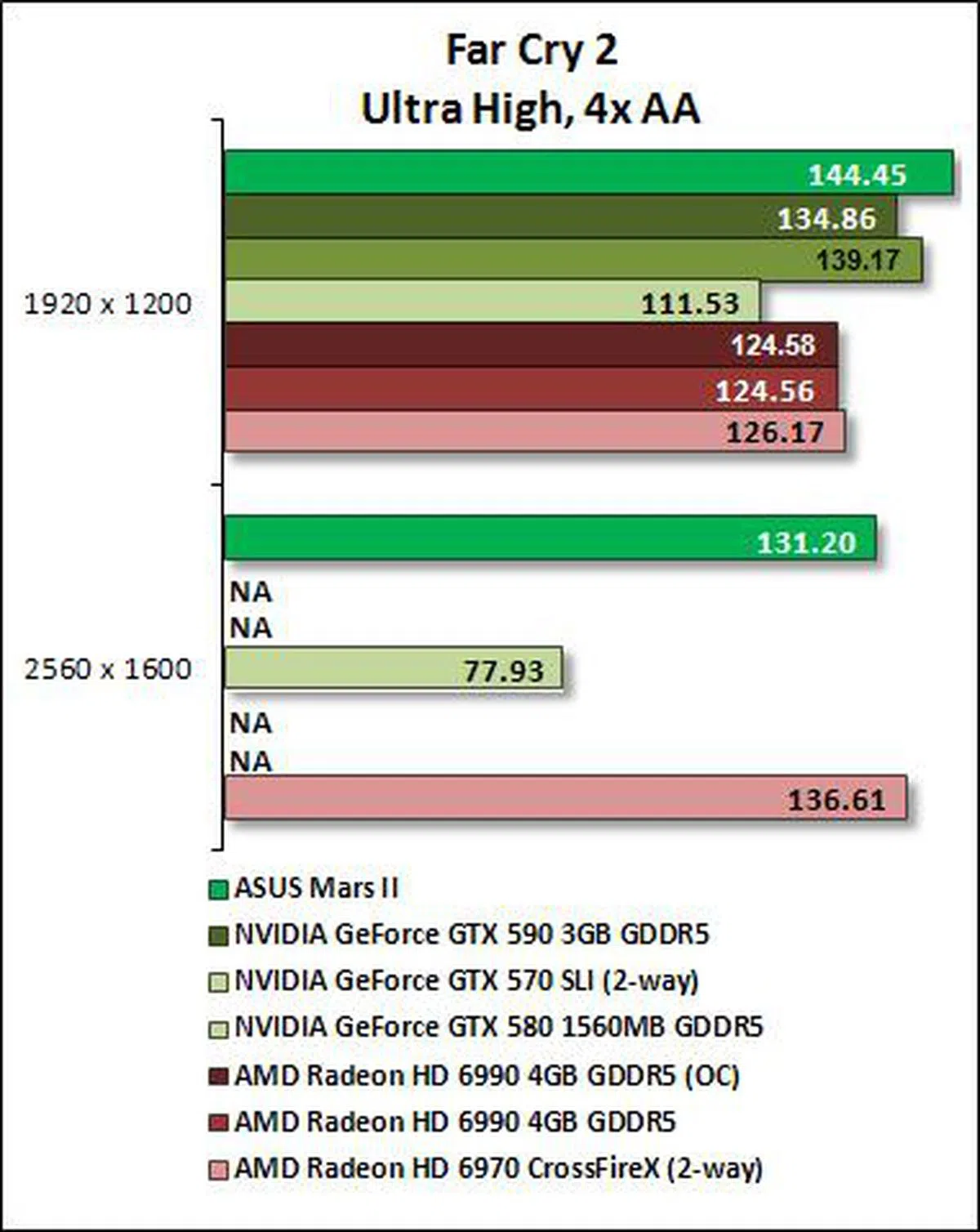 | 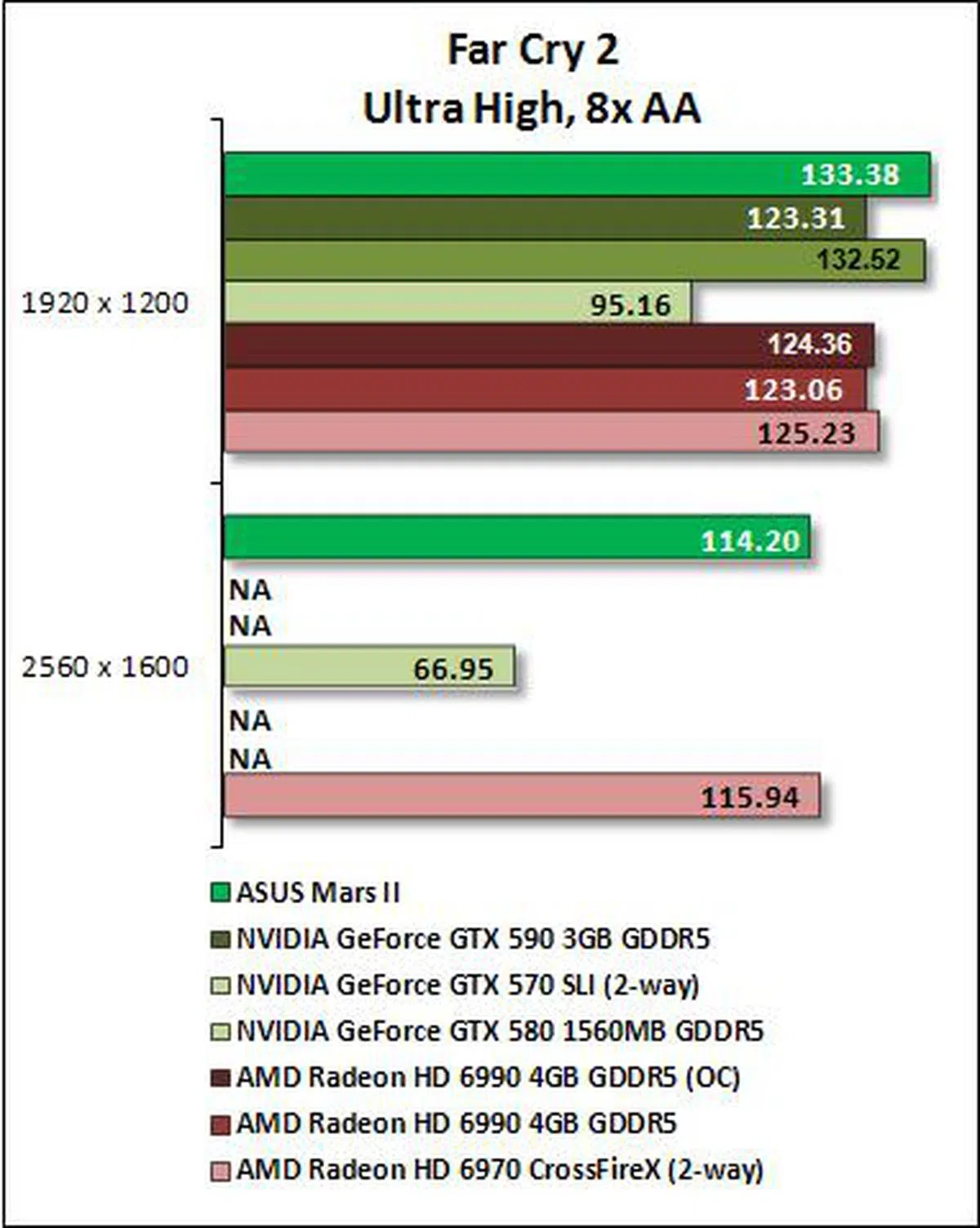 |
Unigine "Heaven" 2.1
DirectX 11 Results
On Unigine’s tessellation-intensive heaven benchmark, with DirectX 11 drivers, the Mars II has the best performance at the highest resolution when compared to the rest of the two competing cards.
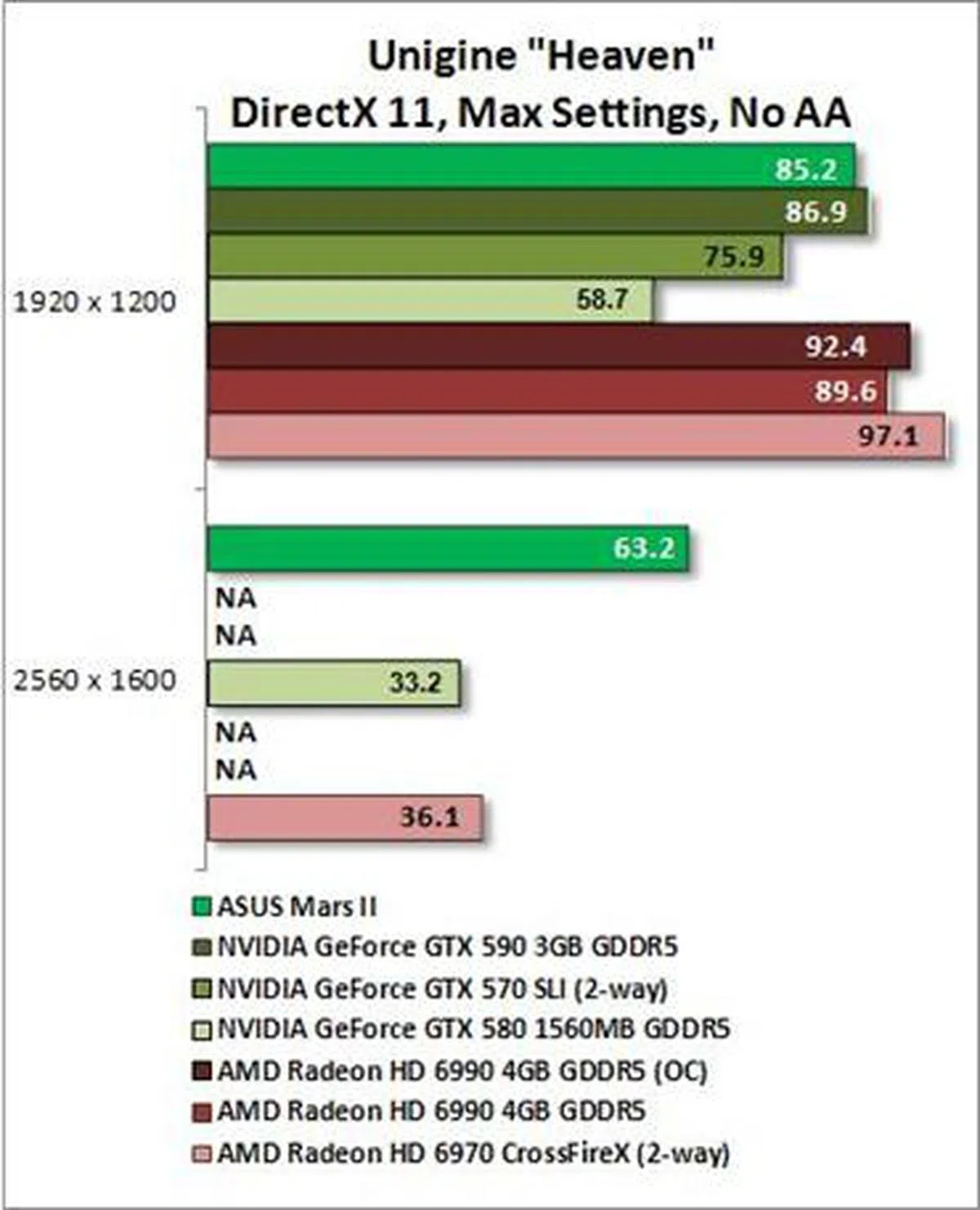 | 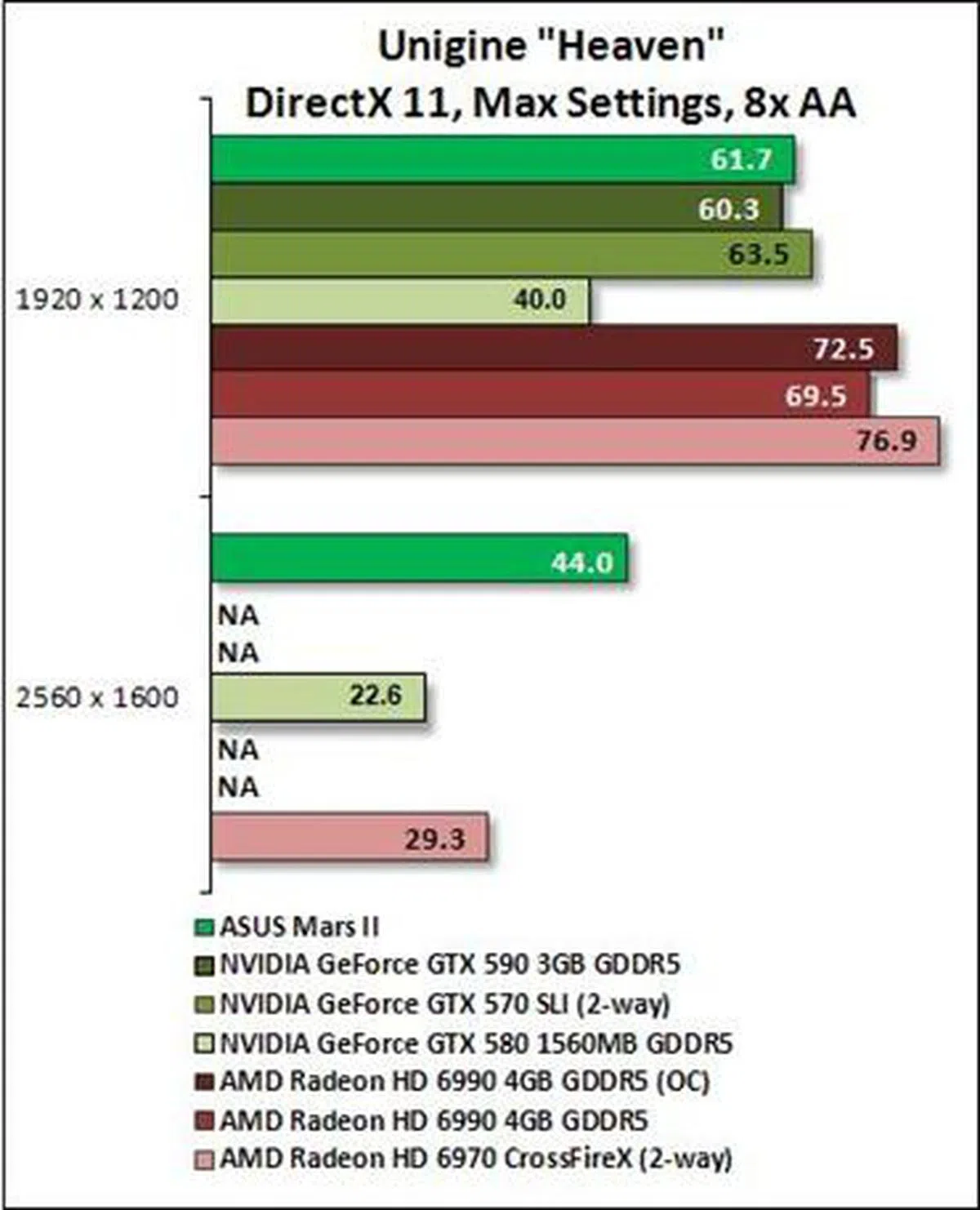 |
DirectX 10 Results
With DirectX 10 drivers, its performance is not so stellar; it only manages to top the rest of the cards at the lower resolution setting of 1920x1200.
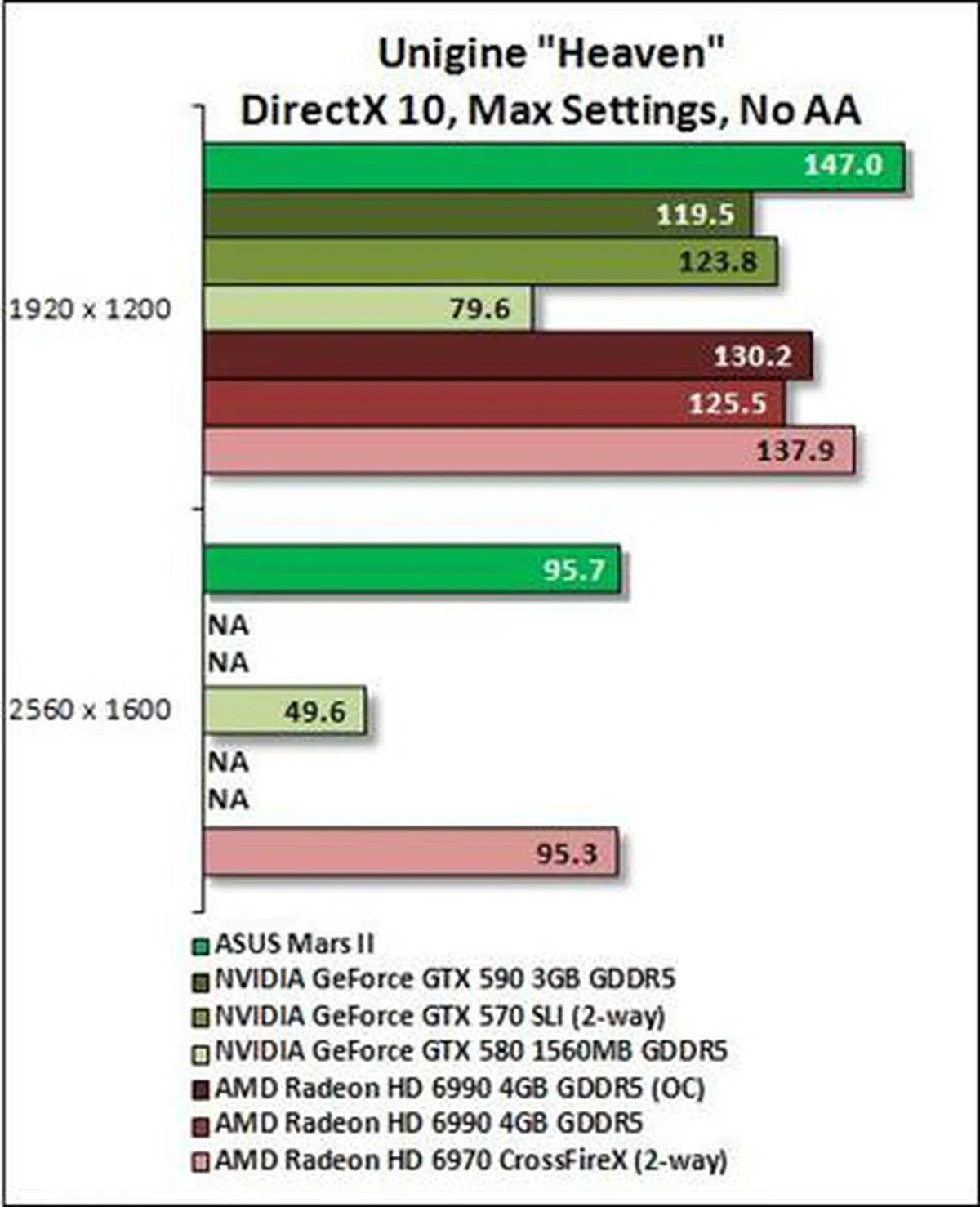 | 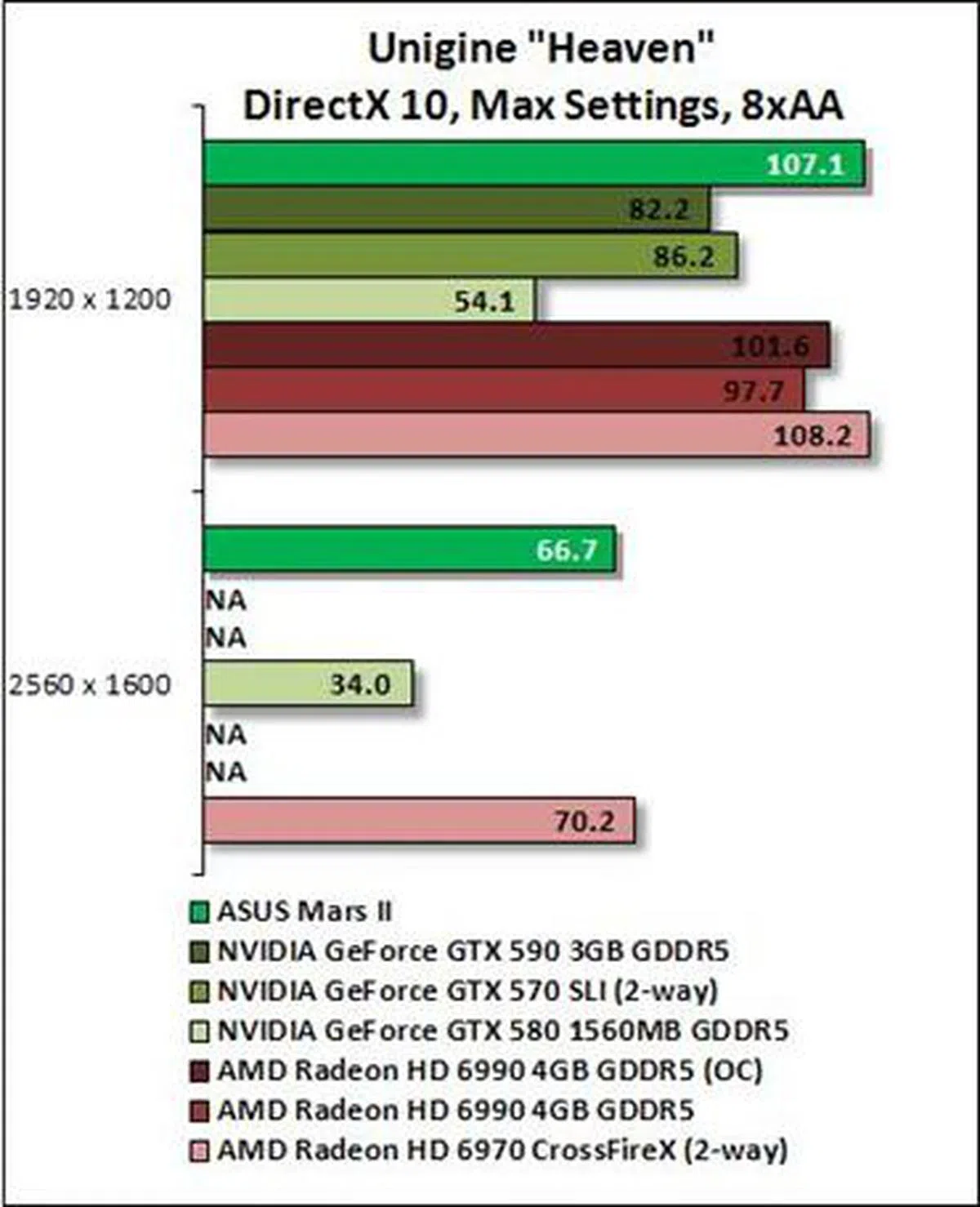 |
S.T.A.L.K.E.R.: Call of Pripyat Results
DirectX 11 Results
On S.T.A.L.K.E.R.: Call of Pripyat with DirectX 11 drivers, the Mars II racked up higher frame rates when running on 2560 x 1600 resolution and with anti-aliasing enabled. On the Day runs, it was approximately 32% faster than the competing pair of Radeon HD 6970 cards and it extended its lead in the SunShaft runs by almost 50%! With anti-aliasing turned off, the results were similar.
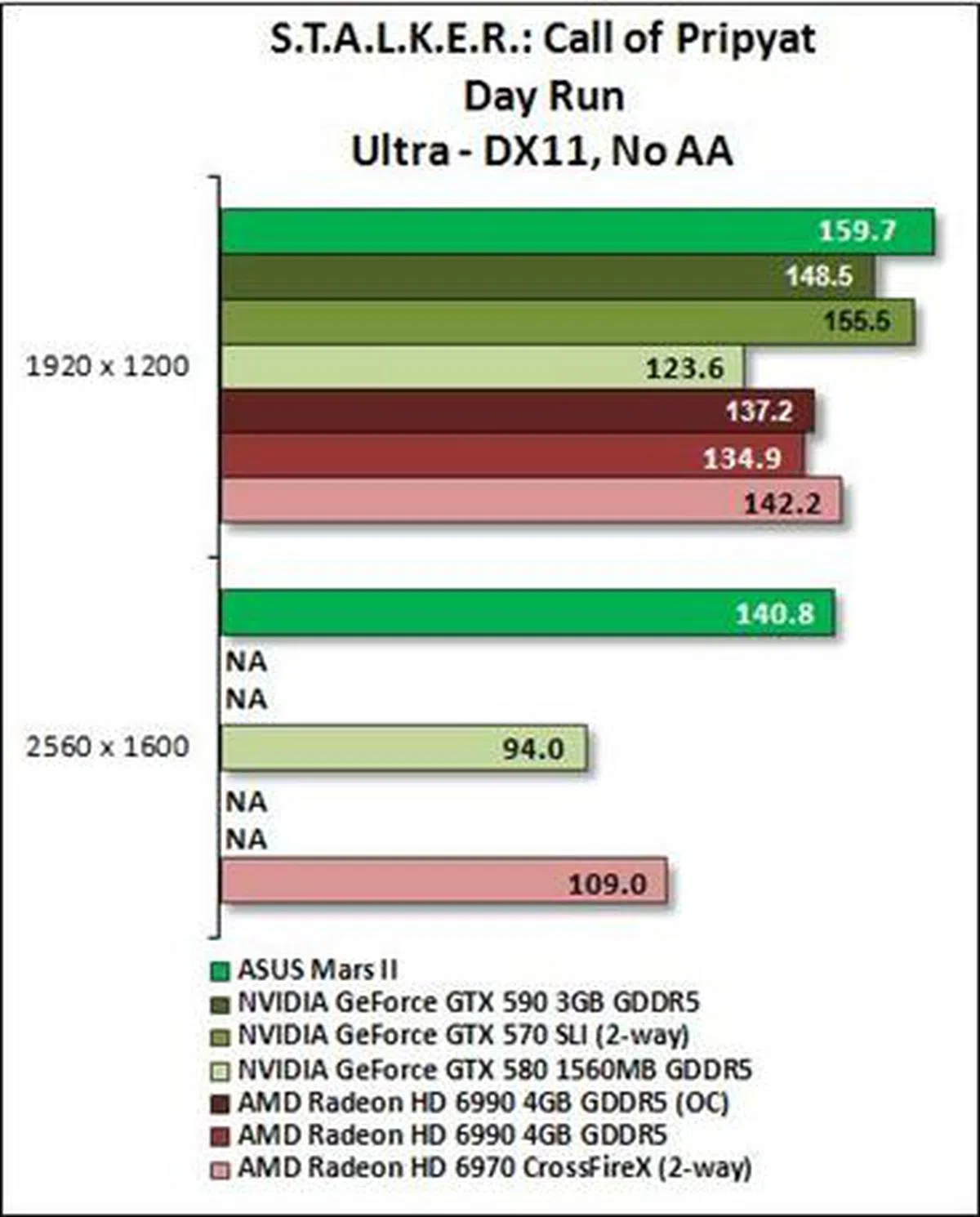 | 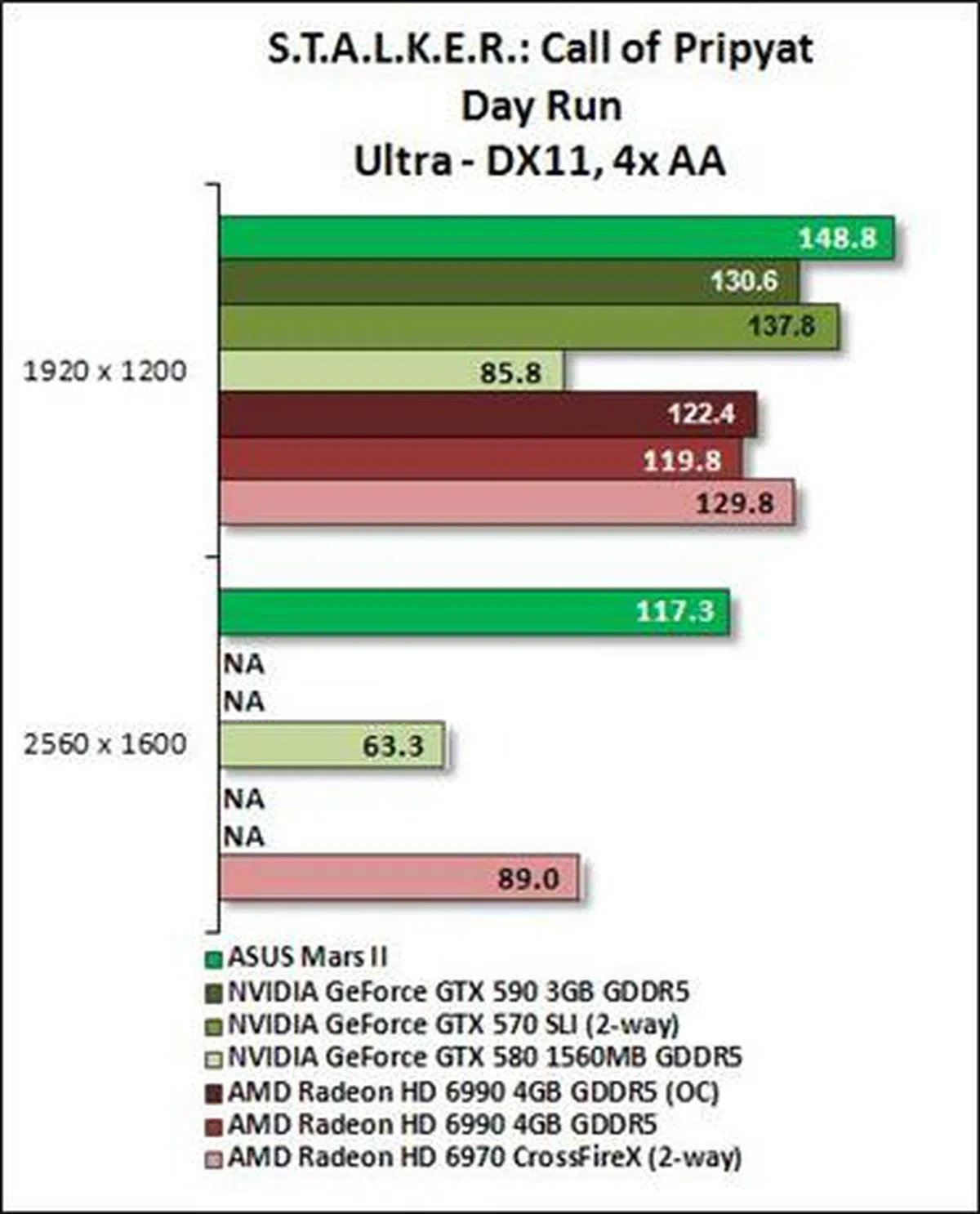 |
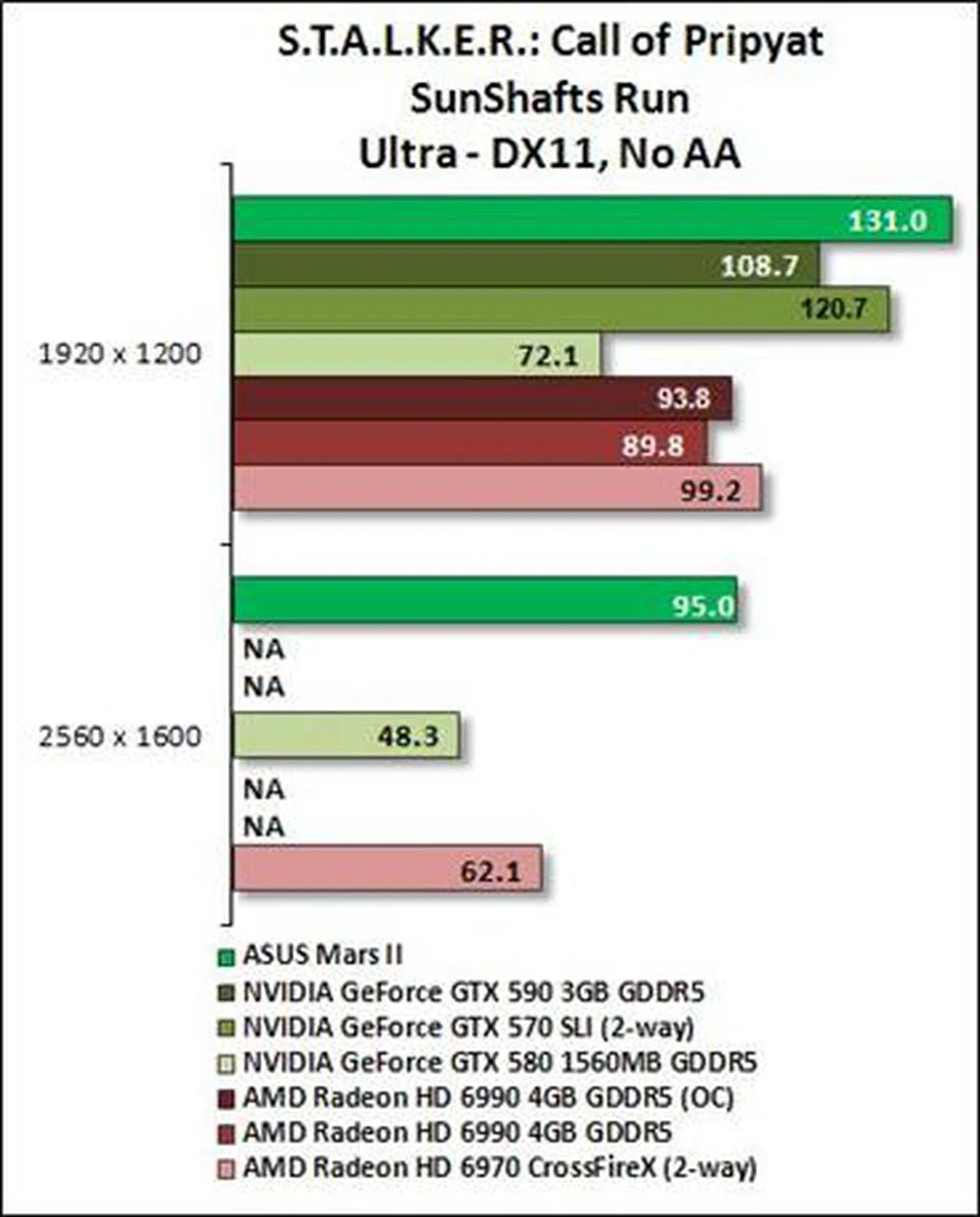 | 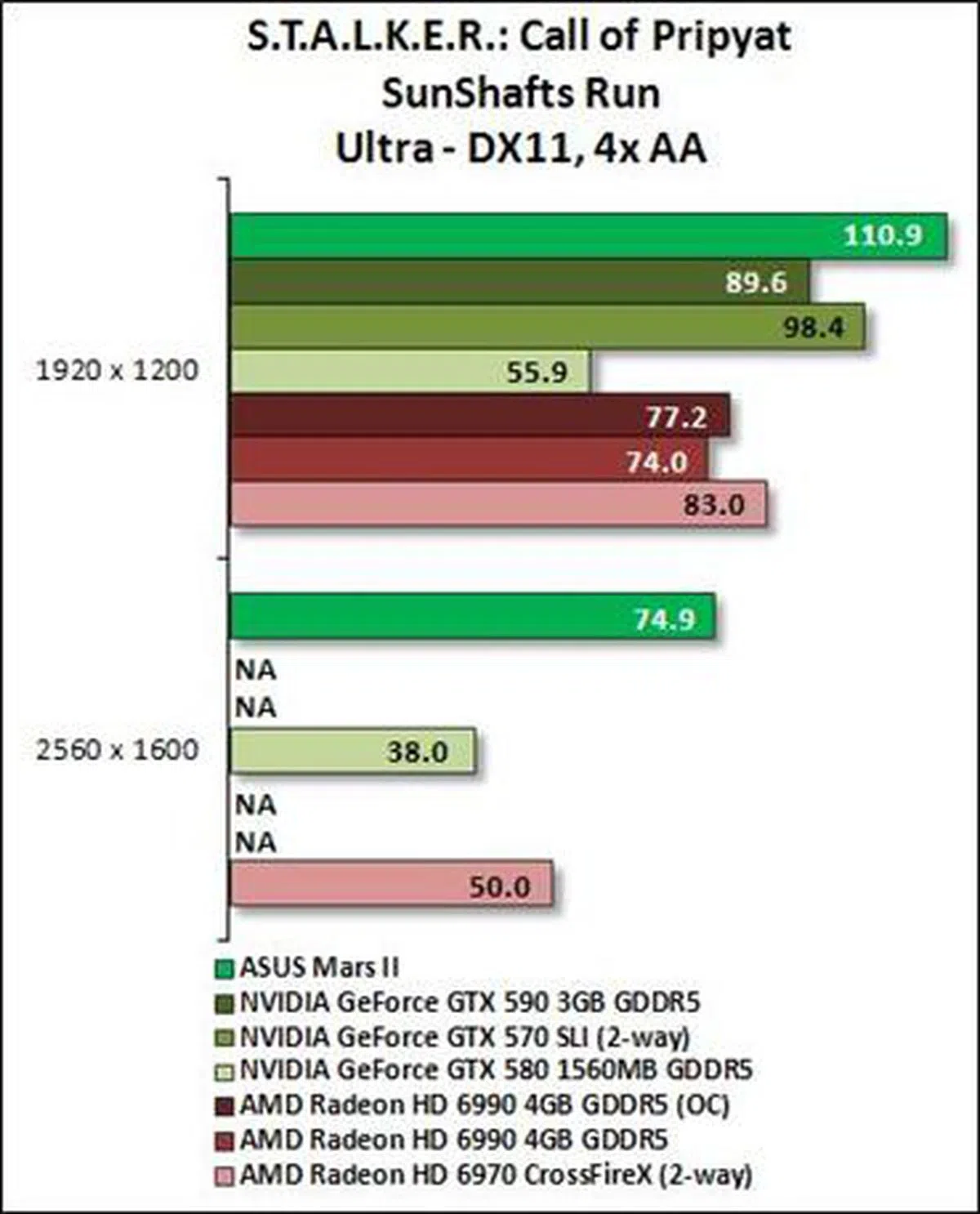 |
DirectX 10 Results
In the Day Run benchmarks, the Mars II turned in higher scores when anti-aliasing is turned on; the exception was when the benchmark was ran at the resolution of 1920 x 1200. The tables turned somewhat with SunShaft runs on DirectX10 drivers as the Radeon HD 6970 pair scored higher than the Mars II. In fact, the highest margin recorded was the 38.1% difference between their respective scores at 1920 x 1200 resolution. This shows that the Radeons are better optimized for DirectX10 applications - which far outnumber DX11 game titles.
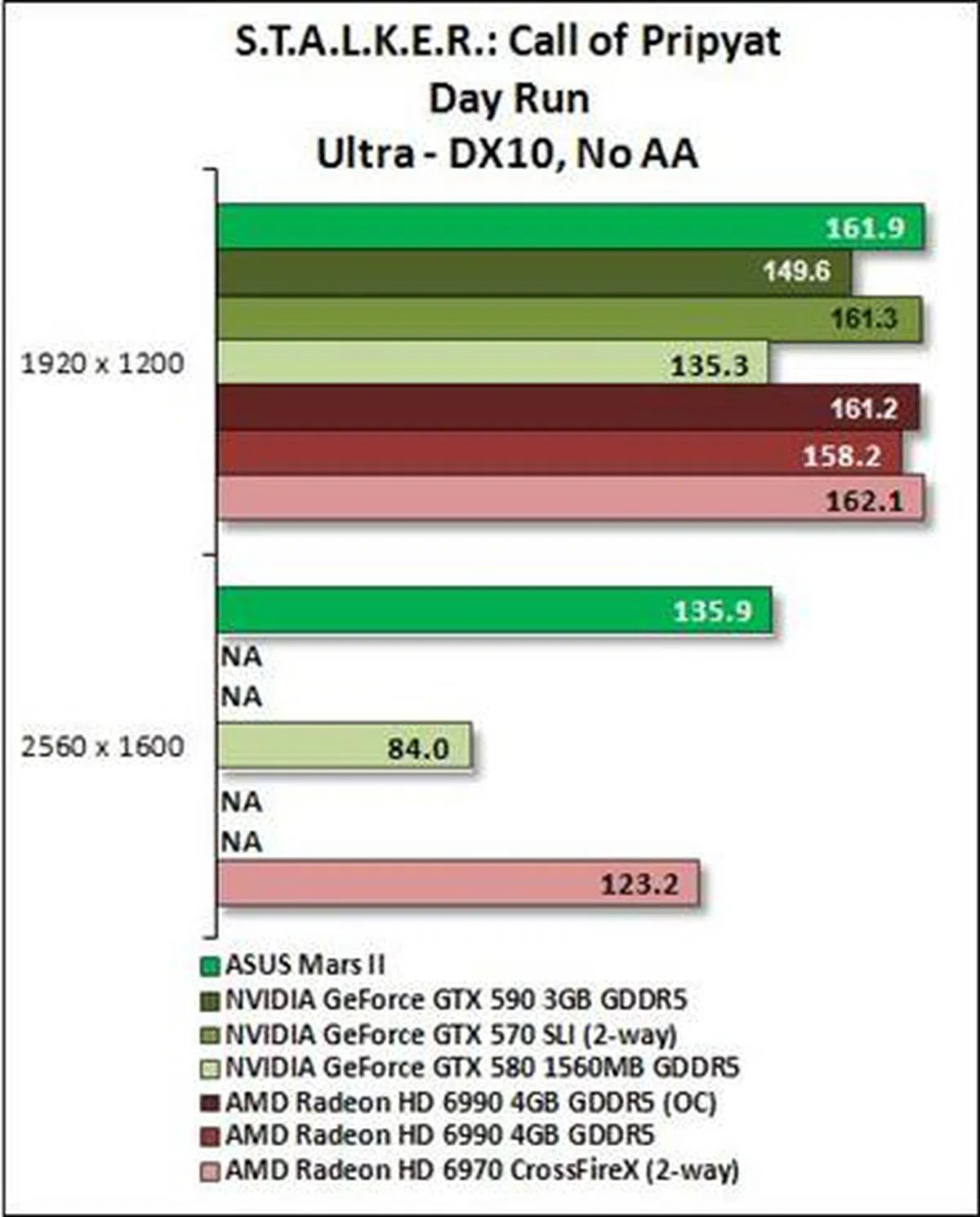 | 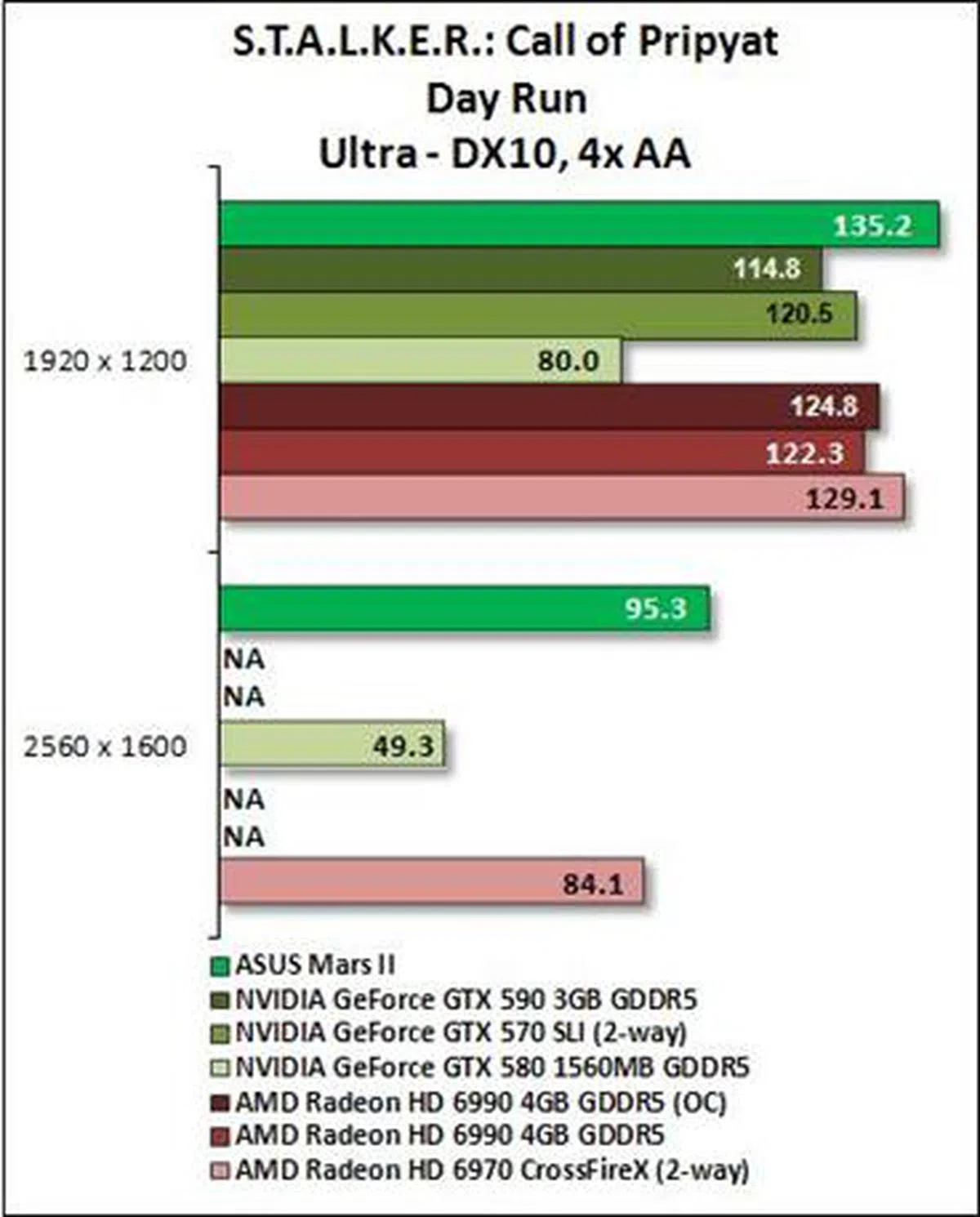 |
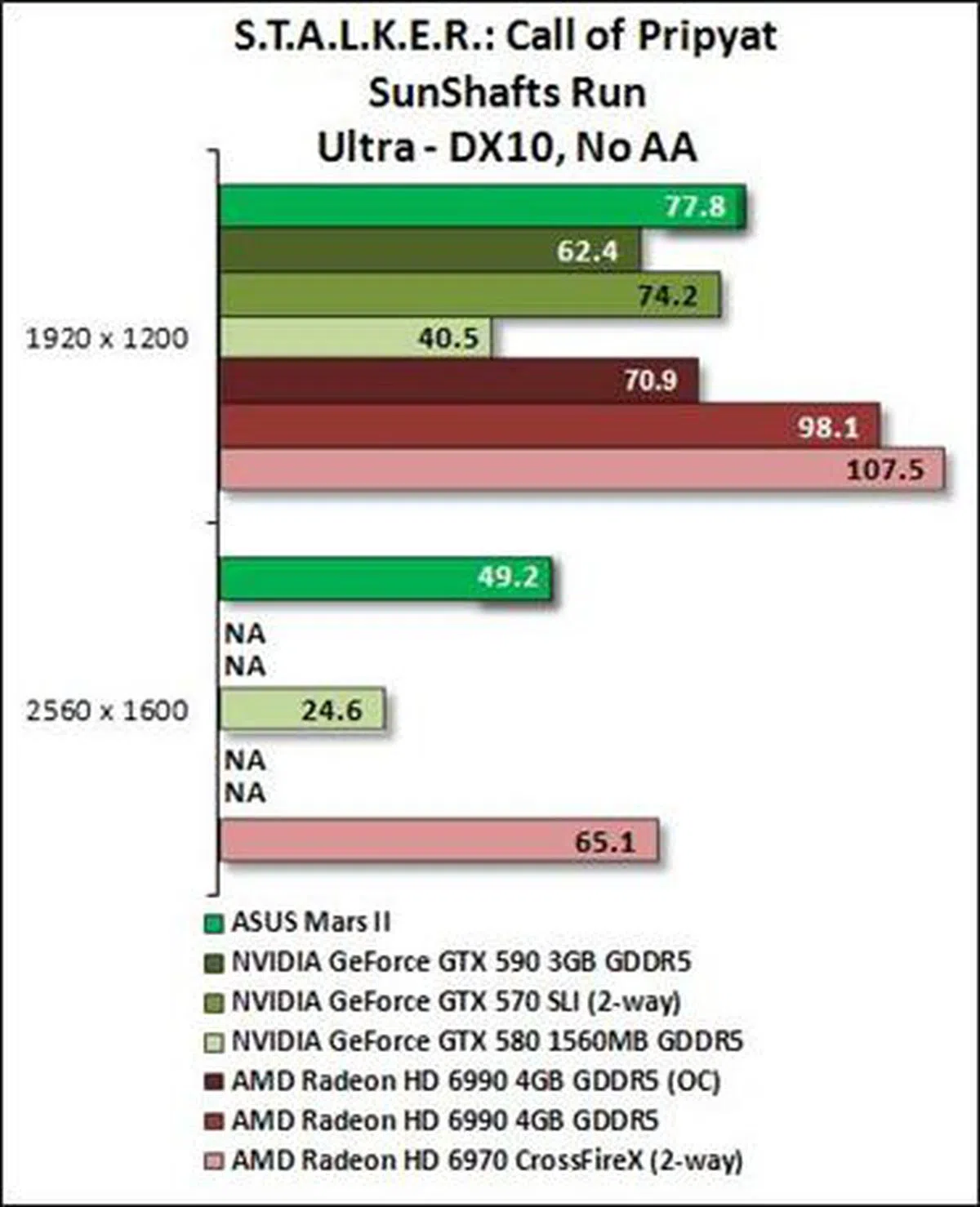 | 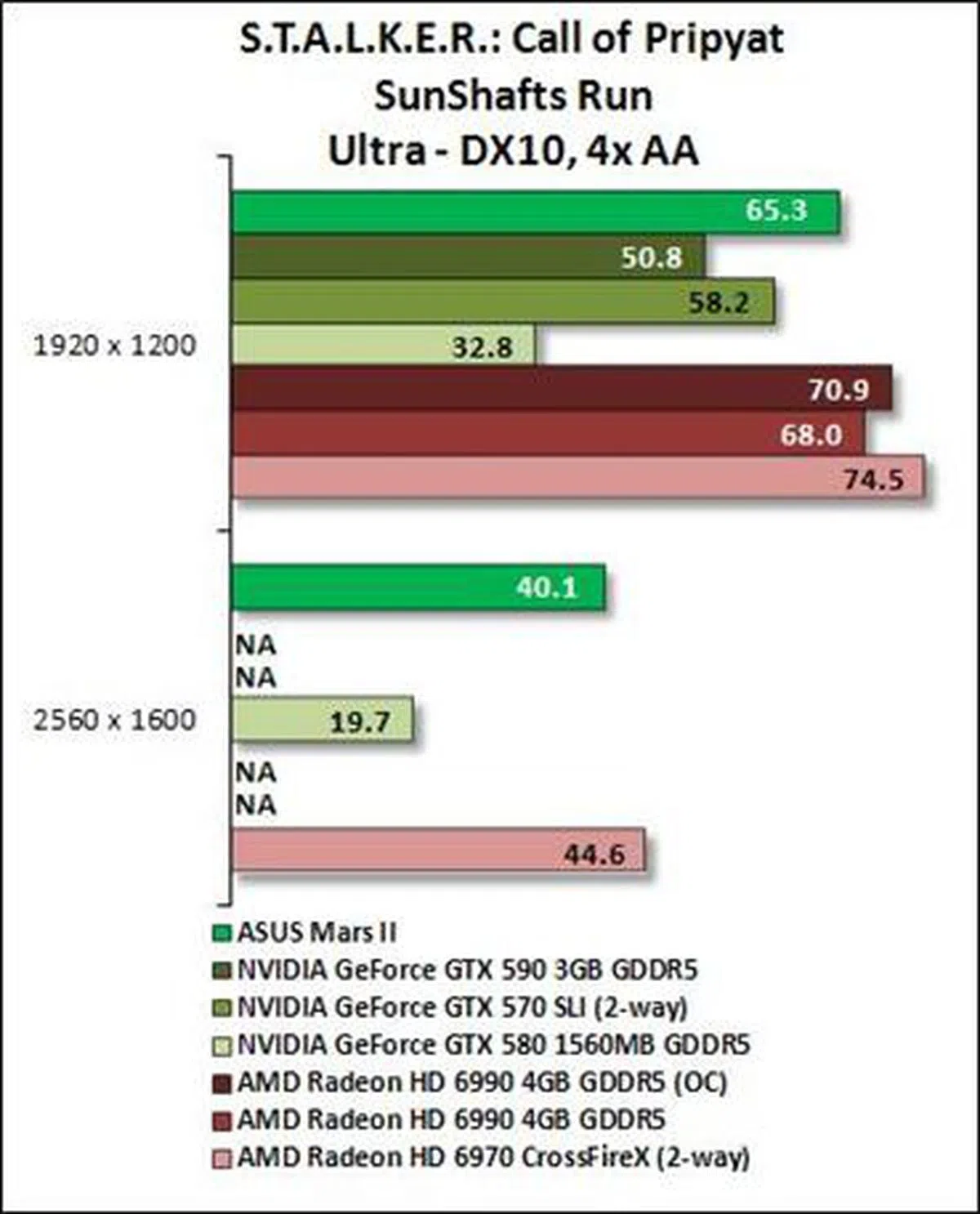 |
Temperature
Heat has always been the bane of dual-GPU cards, but the NVIDIA GeForce GTX 590 fared pretty well in this aspect as we recorded a maximum operating temperature of 70 degrees Celsius, which is pretty impressive for a dual-GPU card of its calibre. Much of this has got to do with the extensive cooling features which NVIDIA implemented on the card, such as the 12-layer copper-infused board, cooling plates, and dual copper vapour chambers.
The Mars II is the coolest card, as we recorded a maximum operating temperature of 66 degrees Celsius. This is due to the pair of 120mm metal fans working together with the large heatsinks and four heatpipes to keep the pair of GPU cores cool.

Power Consumption
The sustained power readings of the Mars II were recorded between 575 and 580W. Its high power consumption is expected as the Mars II is a dual-GPU card and a showcase of the engineering finesse of ASUS. In fact, the highest peak power consumption observed as we put the card through its paces was 615W. On less demanding scenes of the benchmarking tests, the Mars II consumed a sustained power reading of 470W.

Overclocking - the GPU Tweak Way
Using ASUS’ GPU Tweak, we managed to push the Mars II up to a maximum overclocking state of 855MHz at the core and 4250MHz DDR - an increase of 73MHz and 242MHz DDR, respectively. This gave us 20891 3DMarks on the Extreme preset, a decent improvement of 8%. As a safety measure, we left the core voltage setting locked in sync with the core lock setting. This feature of ASUS' also takes out the guesswork for setting the core voltage when overclocking.

To Unleash the Beast...
The Mars II is a limited edition monster card with good overclocking capabilities. Its benchmark performance indicates that in order for it to express its prowess fully, the games have to support DirectX 11, and the graphics should be output to a display capable of rendering them at a resolution of 2560 x 1600 pixels. Anything less would be a mismatch to fully appreciate this powerful graphics card.

How does the Mars II measure up?
Its impressive performance comes at a price, not only financially but in terms of power consumption; it hit a high of 615W during our tests! To keep it from overheating, we decided to keep the pair of cooling fans running at 100%. So do not expect quiet purrs from the Mars II as it is put through its paces during gameplay.
Its performance against a CrossFireX setup of pair of Radeon HD 6970 cards and the GTX 590 was not so clear cut in terms of an all-out triumph. With a total onboard memory of 3GB, its test scores were consistently higher at tests run at 2560 x 1600 pixels resolution with DirectX 11 drivers. With more games being churned out with DirectX 11 support and gamers migrated to larger displays, the dual GPUs of the GTX 580 Mars II will shine bright.
In the coming days, we intend to put the Mars II through its paces against more cards like the GeForce GTX 590 and the AMD Radeon 6990 4GB cards. With a more representative comparison of these cards, we would accord more respect to Asus for their efforts in making the Mars II project see the light of day.
Our articles may contain affiliate links. If you buy through these links, we may earn a small commission.